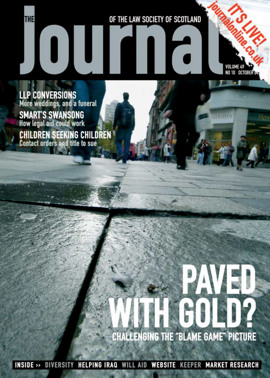Planning a superhighway
While many planning officials may have been keen to participate in the electronic revolution, they have until now been prevented from doing so for formal communications due to the lack of enabling legislation. This changed when the Town and Country Planning (Electronic Communications) (Scotland) Order 2004 (SSI 2004/332) came into force on 28 July.
The Executive, in line with national policy north and south of the border, has been working with local authority officials since 2001 to bring the delivery of planning services into the 21st century. It appreciated that new technology offers opportunities to improve services provided to the general public (and access to services), and to make the planning process more user-friendly.
Moving mountains
Informal access to information, whether by the public or the practising professional, had already improved, with a growing number of publications already available online. However while some local authorities had placed electronic versions of public policy documents (such as local and structure plans) on their websites, the planning application and appeals process itself was still entirely paper-based until July. Applying for planning permission meant filling in copious numbers of planning department forms. Submitting mountains of paper and plans in oversized envelopes can be a complicated and expensive process for applicants. Likewise hard-pressed planning officers must often make and distribute even more copies to internal and external consultees, committing scarce council resources simply to move the paper round the system. Finally, barriers to effective involvement of the general public in the whole planning process include difficulties in viewing statutory plans and applications, commenting on them and tracking their progress.
The Order therefore amends existing legislation by allowing local authorities to receive planning applications and send decision notifications by email. Certain appeals can now be lodged electronically, e.g. against refusal of planning permission or non-determination of a planning application. In some cases the requirement to supply multiple copies of documents is also relaxed. However a postal address will generally still be required in addition to an email address.
Electronic communication may not be used in every case. A notice cannot be served electronically where non-compliance would lead to criminal sanctions (e.g. enforcement notices, though an appeal against an enforcement notice may now be lodged electronically). Presumably until technology can allow the planning authority to be sure that the relevant person has seen a notice, the traditional requirements to servepersonally or by post will stand.
Commendations all round
The Order is also intended to facilitate use of the internet. Objectives therefore include:
General information
- Internet sites for each planning authority and the Scottish Executive (including the Inquiry Reporters Unit);
- Online planning information, policies, guidance notes and advice;
- Online structure and local plans;
- Helplines for enquiries.
Applications
- Downloadable application forms;
- Online submission of planning and related applications and payment of fees;
- Online opportunity to comment on applications;
- Online applications lists and tracking of progress;
- Online decisions.
Appeals
- Downloadable appeals forms;
- Online submission of appeals and payment of fees;
- Online tracking of progress;
- Online decisions.
While not all local authorities have yet tackled all of these, great progress has been made. We wholeheartedly recommend the Scottish Executive’s Planning webpage (www.scotland.gov.uk/Topics/Planning-Building/Planning), containing national planning policies, guidance, advice, research and consultation papers, direct links to local authority websites and much more. Crucially it also includes a link to the Inquiry Reporters Unit’s section for details of appeals and inquiries, with an online facility to search for decision letters. (Hopefully we will never again have to trawl through voluminous papers, files and inquiry documentation trying to recall where we filed the decision letter!)
We also entirely commend the local authorities whose structure and local plans are already online. This alone is a major step forward for busy property lawyers faced with the question “What is the land/site zoned for?” and improves access to important planning policies for members of the communities affected by them. Both the City of Edinburgh and Stirling Councils now offer online access to application information. Their sites are effective and accessible, providing up-to-date information and advice. The City of Edinburgh Council also has downloadable application forms for online submission of planning applications.
The e-planning initiatives are to be universally applauded. Indeed the City of Edinburgh Council’s planning portal received more than 100,000 hits in its first year. There is clearly now both a substantial customer demand for online services and a great opportunity for property lawyers and the public alike to access planning information more quickly and cheaply than ever before.
Robin Priestley and Victoria Stewart, Planning and Environment, Anderson Strathern
In this issue
- Citizenship, society and solicitors
- The well unfair state
- Litigation nation
- Best medicine
- Take a deep breath
- What title?
- Walk this way?
- Know your strategy
- e-quilibrium?
- The researchers
- Rights out of anarchy
- Political correctness or positive change?
- Steering clear
- How far can a board go?
- Major role for new tribunal
- The race is on (again)
- Planning a superhighway
- Website reviews
- Book reviews
- Single survey's lonely heart
- In harmony
- Clearing the path






